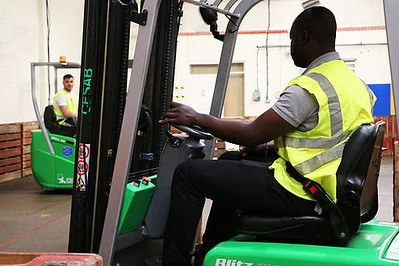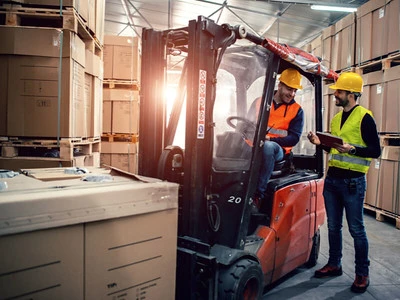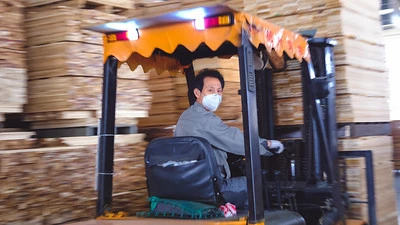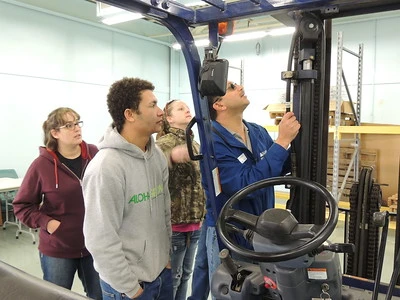Who Provides the Best Counterbalance Forklift Training?
May 13, 2024 | by onlineoshasafetytraining.com


Looking for the best training to handle a counterbalance forklift? Getting the right training is crucial, not just for your safety but also to make sure you can operate these machines efficiently and maintain them properly.
In this article, we’ll explore the top training providers, what makes their training stand out, and how to choose the best one for your needs. Whether you’re a beginner or need a refresher course, we’ve got you covered!
Key Features of Quality Forklift Training
When you’re looking for top-notch forklift training, here are the key features you should expect:

- Certified and Experienced Trainers
- Having instructors who are not only certified to teach but also have years of experience operating forklifts is crucial. These trainers have been in the field and faced real-life situations, so they can share practical insights and safety tips that go beyond textbook knowledge. They know the common mistakes to avoid and can help you become more proficient faster.
- Comprehensive Curriculum
- A well-rounded training program doesn’t just teach you how to drive a forklift. It covers all the essential areas: safety procedures to prevent accidents, operational techniques to handle different loads and environments, and maintenance practices to keep the forklift working properly. This complete approach ensures you are prepared for everything from daily operations to dealing with unexpected issues.
- Hands-On Training Opportunities
- The best way to learn is by doing. That’s why high-quality forklift training includes plenty of time actually operating the forklift under the supervision of knowledgeable instructors. This hands-on experience allows you to apply what you’ve learned in a safe, controlled setting before you take on the responsibility in a real work environment. It’s about building confidence as much as it is about building skills.
- Availability of Refresher Courses
- Operating environments and safety regulations can change, and even experienced forklift operators can benefit from updates on the latest practices. Refresher courses serve this purpose. They help seasoned operators recall and renew their knowledge, ensuring they remain competent and compliant with current safety standards. These courses also provide a chance to learn about new forklift technologies and techniques.
Each of these features plays a critical role in ensuring that forklift training is effective, practical, and relevant, helping you to operate safely and efficiently on the job.
Top Providers of Counterbalance Forklift Training
Here’s a breakdown of where you can find top-quality training for operating counterbalance forklifts, explained in simple terms:

- National Associations or Organizations That Offer Accredited Programs
- Across the country, there are several official groups that specialize in forklift training. These organizations are recognized for their high standards and have programs that meet all legal and safety requirements. Training with these groups ensures you’re getting instruction that’s up-to-date and widely respected in the industry. They provide certifications that are recognized everywhere, making it easier for you to find jobs and prove your skills.
- Reputable Local Training Centers: What to Look For
- Local training centers can be great because they are close by and often less expensive. But it’s important to check that they have a good reputation. Look for centers that offer certified trainers, a comprehensive curriculum, and good equipment for training. It’s also helpful to ask around or check online reviews to see what other students have said about their training experience. Ensure they provide a certification that employers in your area recognize.
- Online Training Options: Are They Sufficient?
- Online training can be a convenient and flexible way to learn, especially if you’re juggling a busy schedule. These courses can cover the theory part of forklift operation, like safety guidelines and operational principles. However, operating a forklift also requires practical skills that you can only develop through actual hands-on practice. Therefore, while online courses are useful for learning the basics or for refresher training, they should be complemented with in-person training to gain real-life operating experience.
Each of these options has its own advantages, and the best choice for you might depend on your specific situation, such as your location, budget, and learning style.
Here are some of the best national forklift training providers in the US, along with their contact details and key offerings:
- National Forklift Foundation
- Offers a self-paced, OSHA-compliant online training program that’s accessible on mobile or tablet devices. It’s suitable for beginners and those needing recertification. The program includes interactive lessons, videos, and detailed text-based resources. Upon completion, participants can print their certificate and receive an official certification wallet card.
- Forklift Academy
- Known for being one of the largest training schools in the US with over 20 years of experience, Forklift Academy provides both online and in-person forklift training and certification. They offer ‘train the trainer’ courses and a variety of training materials.
- H&E Equipment Services
- Provides a wide range of services including on-site training and certification for forklifts. Their training is OSHA-compliant and includes classroom and hands-on sessions which can be scheduled at your convenience.
- United Rentals
- As the largest equipment rental company worldwide, United Rentals offers extensive safety training programs for various forklift models. Training methods include in-person classroom training, hands-on sessions, online programs, and blended learning.
- NITCO
- Offers OSHA-compliant online and in-person forklift training programs, including ‘train the trainer’ courses. Their in-person training involves classroom learning followed by an exam and hands-on training.
Each of these providers offers comprehensive forklift training programs tailored to both beginners and experienced operators, ensuring safety and compliance with OSHA standards.
Benefits of Choosing a Reputable Trainer
Choosing a reputable trainer for forklift training offers several important benefits:

- Safety Improvements and Accident Reduction
- A reputable trainer will emphasize safety protocols and proper handling techniques, significantly reducing the likelihood of accidents and injuries. Well-trained operators are more aware of potential hazards and more proficient in managing them, which contributes to a safer workplace environment.
- Compliance with Occupational Health and Safety Regulations
- Compliance with safety standards and regulations is not just a legal requirement; it also protects businesses from potential fines and legal issues. Reputable trainers ensure their programs are up-to-date with the latest Occupational Safety and Health Administration (OSHA) guidelines and other relevant standards, helping companies maintain compliance and avoid penalties.
- Better Job Opportunities for Certified Operators
- Operators who receive training from recognized and respected trainers are often more sought after by employers. This certification signals to potential employers that the operator has received thorough training and is capable of performing at a high standard, leading to better job opportunities and potentially higher wages.
Overall, investing in quality forklift training through a reputable trainer is beneficial for both the individual operator and the organization, promoting safety, compliance, and career advancement.
How to Choose the Right Training Provider
Choosing the right forklift training provider is crucial for ensuring you receive quality training that meets industry standards and enhances your job prospects. Here are some key factors to consider when selecting a training provider:

- Factors to Consider
- Location: The proximity of the training center to your home or workplace can influence your decision, especially if it involves regular commuting.
- Cost: Compare the fees of different providers to find a training that fits your budget. Remember, the cheapest option might not always offer the best value.
- Reviews: Look up reviews and testimonials from past students. This can provide insights into the quality of training and the effectiveness of the instructors.
- Checking Accreditations and Certifications
- Ensure that the training provider is accredited by relevant industry bodies. This accreditation means that the provider meets certain standards in training delivery and curriculum design. For forklift training, accreditations from organizations like OSHA (Occupational Safety and Health Administration) in the U.S. are crucial indicators of compliance and quality.
- Asking for Recommendations from Industry Peers
- Speak to colleagues, supervisors, or other industry contacts who have undergone forklift training. Personal recommendations can help you gauge the effectiveness of the training and the reputation of the provider in the industry.
By carefully evaluating these factors, you can choose a forklift training provider that best meets your needs, ensuring that you receive comprehensive training that enhances your skills and employability.
What to Expect During Counterbalance Training
When signing up for counterbalance forklift training, here’s what you can typically expect regarding the duration, content, and assessment process of the program:
- Typical Duration and Structure of the Training Programs
- Most forklift training courses last anywhere from one day to a week, depending on the depth of instruction and the operator’s prior experience. The training usually includes a mix of classroom-based learning and practical, hands-on experience. Trainees will spend time understanding the theory behind operation and safety in the classroom and then apply this knowledge practically by operating a forklift under supervision.
- Key Topics Covered During the Training
- The training program will cover a range of essential topics, including:
- Safety protocols: Learning all safety measures to prevent accidents.
- Operation techniques: How to operate the forklift, including starting, moving, lifting, and placing loads.
- Maintenance basics: Basic forklift maintenance to ensure the machine operates smoothly and safely.
- Handling emergencies: What to do in case of mechanical failure or other emergencies.
- These topics are crucial for ensuring safe and efficient operation of the forklift.
- The training program will cover a range of essential topics, including:
- Assessment and Certification Process
- At the end of the training, you’ll likely go through an assessment that tests your knowledge and skills. This might include a written test and a practical demonstration of your ability to operate a forklift safely.
- If you pass the assessment, you will receive a certificate or a license that proves you have completed the training and are qualified to operate a forklift. This certification is often required by employers and needs to be renewed periodically, typically every three years, or if you are involved in an accident or observed operating the forklift unsafely.
This structured approach to training ensures that you not only learn the critical skills required but also validate your ability to apply them in a work environment.
To Make a Conclusion
Choosing the best provider for counterbalance forklift training means looking for top-notch programs that teach you everything from safety to daily operation skills. Whether it’s a nationally recognized organization, a trusted local center, or even online courses for convenience, the right training makes all the difference.
Remember, the best trainers not only teach you the ropes but also help you become a certified, safe, and efficient forklift operator. Take your time, check their credentials, read reviews, and maybe ask a few people in the field. Investing in the right training program opens doors to better job opportunities and ensures you work safely and smartly.
RELATED POSTS
View all


